If I Have an Old Lump on My Forehead and Then Fall and Hit It Again
Head injury - showtime assistance
Encephalon injury; Head trauma
A head injury is whatsoever trauma to the scalp, skull, or encephalon. The injury may exist only a small-scale bump on the skull or a serious brain injury.
Head injury can be either closed or open (penetrating).
- A closed head injury ways you received a hard accident to the caput from striking an object, just the object did not suspension the skull.
- An open, or penetrating, caput injury means you were hit with an object that broke the skull and entered the brain. This is more likely to happen when you move at high speed, such as going through the windshield during a motorcar blow. It tin also happen from a gunshot to the head.
Head injuries include:
- Concussion, in which the brain is shaken, is the most common blazon of traumatic encephalon injury.
- Scalp wounds.
- Skull fractures.
Head injuries may cause haemorrhage:
- In the brain tissue
- In the layers that surroundings the encephalon (subarachnoid hemorrhage, subdural hematoma, extradural hematoma)
Head injury is a common reason for an emergency room visit. A large number of people who suffer head injuries are children. Traumatic brain injury (TBI) accounts for over 1 in half-dozen injury-related hospital admissions each year.
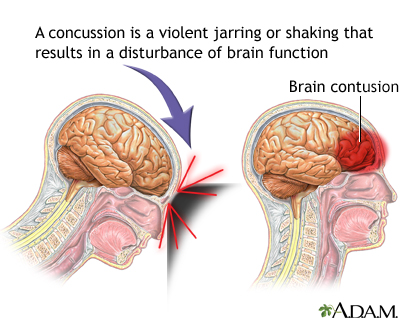
A concussion may result when the head strikes confronting an object or is struck by an object. Concussions may produce unconsciousness or bleeding in or around the brain.
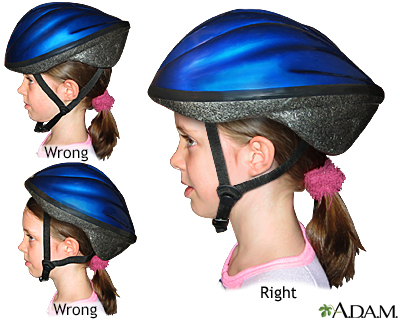
Helmets can save lives and prevent trauma, only merely if they are worn properly. A helmet should be worn squarely on the tiptop of the head, covering the pinnacle of the brow. The chinstrap must be fastened and the helmet should fit snugly and comfortably. The helmet should non exist able to move side-to-side or front-to-back. Most helmets come up with removable pads and then you tin customize the fit for whatever child.
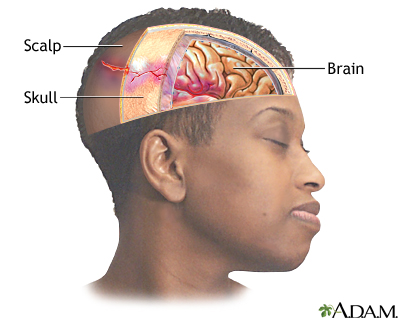
Head injuries tin can range from a small bump on the caput to a devastating brain injury. Learning to recognize a serious head injury, and implementing basic commencement aid, tin make the difference in saving someones life. Mutual causes of caput injury include traffic accidents, falls, concrete set on, and accidents at home, work, outdoors, or while playing sports.
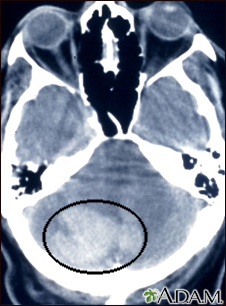
Intracerebellar hemorrhage shown past CT browse. This hemorrhage followed use of t-PA.
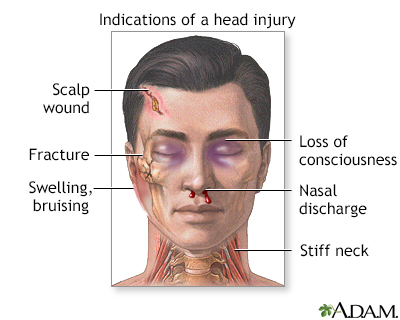
Head injury can be classified as either closed or penetrating. In closed head injury, the head sustains a blunt strength by hitting against an object. In penetrating head injuries, a high velocity object breaks through the skull and enters the brain. The signs and symptoms of a head injury may occur immediately or develop slowly over several hours.
You've fallen and hit your head. It hurts a picayune, but you're not bleeding and you feel okay. Practise you lot have a head injury, or are you fine? Knowing how to tell a minor caput injury from a serious one could literally save your life. Let's talk about caput injuries. Millions of people get head injuries every year. They become into auto accidents or fights, they fall, or they get hit in the caput while playing sports or working on the chore. Most head injuries are small-scale, because your head comes equipped with its ain natural difficult hat, a protective skull that surrounds and protects your brain. But sometimes that protection isn't enough. More than a half-1000000 people each twelvemonth get head injuries severe enough to send them to the hospital. The most common type of caput injury is a concussion. That's when a hit in the caput makes your brain jiggle effectually in your skull. You tin can also get a bruise on your brain, called a contusion. Brain contusions are a lot more serious than bruises from a bump on the arm or leg. Other types of head injuries include a fractured skull or a cut on your scalp. If y'all become hitting in the head or fall and you don't bleed, you've got a closed head injury. If an object enters your brain, like glass from a windshield during a car accident or a bullet from a gunshot, so yous have an open head injury. It can be very hard to tell if you've got a modest airtight head injury or a serious ane. Your head might wait perfectly fine from the outside, when you actually have bleeding or swelling within your brain. To tell the divergence, look for other signs of a serious caput injury, such as a severe headache; Articulate or encarmine fluid coming from your nose, ears, or mouth; Confusion, drowsiness, or a loss of consciousness; Changes in the way you hear, see, gustation, or smell; memory loss; mood changes or foreign behaviors; slurred spoken language or recurrent vomiting. If you or someone else has whatever of these symptoms, call for medical help right away. If you lot don't accept these symptoms and you think information technology's just a minor head injury, you probably don't need to exist treated. Just ask a friend or family fellow member to go on an eye on you. If it's your kid or someone else with the head injury, wake them up from sleep every 2 or 3 hours to ask questions similar, Where are y'all? and What's your name? but to make certain they're alert. If you're in any doubt about whether a head injury is serious, play it safety and get medical assistance. To play it even safer, protect your head during whatsoever activities that could lead to an injury. Wear a helmet whenever you skateboard, roller skate, ski, snowboard, or ride a bike or motorcycle. Put on your seatbelt whenever you're in the automobile. And put kids in an age-appropriate motorcar seat or booster seat.
Causes
Common causes of caput injury include:
- Accidents at home, work, outdoors, or while playing sports
- Falls
- Physical assault
- Traffic accidents
Well-nigh of these injuries are pocket-sized because the skull protects the brain. Some injuries are severe enough to require a stay in the hospital.
Symptoms
Head injuries may cause bleeding in the brain tissue and the layers that surround the brain (subarachnoid hemorrhage, subdural hematoma, epidural hematoma).
Symptoms of a head injury tin occur right away or may develop slowly over several hours or days. Even if the skull is not fractured, the brain can hit the within of the skull and be bruised. The caput may wait fine, just problems could issue from bleeding or swelling inside the skull.
The spinal cord is also likely to be injured from falls from a significant top or ejection from a vehicle.
Some caput injuries crusade changes in encephalon function. This is called a traumatic encephalon injury. Concussion is a traumatic brain injury. Symptoms of a concussion can range from mild to severe.
Kickoff Help
Learning to recognize a serious head injury and requite bones first aid can save someone's life. For a moderate to astringent head injury, Call 911 RIGHT AWAY.
Go medical assistance right away if the person:
- Becomes very sleepy
- Behaves abnormally, or has spoken communication that does not make sense
- Develops a severe headache or stiff neck
- Has a seizure
- Has pupils (the dark central part of the heart) of unequal sizes
- Is unable to motility an arm or leg
- Loses consciousness, even briefly
- Vomits more than once
And so take the following steps:
- Cheque the person'south airway, animate, and circulation. If necessary, begin rescue breathing and CPR.
- If the person's animate and heart rate are normal, but the person is unconscious, treat as if there is a spinal injury. Stabilize the head and neck past placing your hands on both sides of the person's caput. Keep the head in line with the spine and prevent movement. Wait for medical help.
- Stop whatsoever bleeding past firmly pressing a clean material on the wound. If the injury is serious, exist careful not to motility the person's head. If claret soaks through the cloth, do not remove it. Place another cloth over the outset ane.
- If you suspect a skull fracture, practice non apply direct pressure to the bleeding site, and do not remove any droppings from the wound. Cover the wound with sterile gauze dressing.
- If the person is vomiting, to preclude choking, roll the person's head, neck, and body as one unit onto their side. This still protects the spine, which yous must always assume is injured in the case of a caput injury. Children often vomit once after a head injury. This may not exist a trouble, but phone call a medico for further guidance.
- Apply water ice packs to swollen areas (embrace ice in a towel then it does not directly touch the pare).
Do Not
Follow these precautions:
- DO Non wash a head wound that is deep or bleeding a lot.
- DO NOT remove whatsoever object sticking out of a wound.
- Do Non movement the person unless admittedly necessary.
- DO NOT shake the person if they seem dazed.
- Practise NOT remove a helmet if you suspect a serious head injury.
- DO NOT option up a fallen child with whatever sign of caput injury.
- DO NOT drink alcohol within 48 hours of a serious head injury.
A serious head injury that involves bleeding or encephalon damage must be treated in a hospital.
For a mild head injury, no treatment may be needed. However, call for medical advice and spotter for symptoms of a head injury, which can testify up later.
Your health care provider will explain what to expect, how to manage any headaches, how to care for your other symptoms, when to render to sports, school, piece of work, and other activities, and signs or symptoms to worry about.
- Children will need to be watched and make activity changes.
- Adults also need close ascertainment and action changes.
Both adults and children must follow the provider's instructions about when it volition be possible to return to sports.
When to Contact a Medical Professional
Call 911 right abroad if:
- There is severe head or face bleeding.
- The person is confused, tired, or unconscious.
- The person stops breathing.
- You suspect a serious head or neck injury, or the person develops any signs or symptoms of a serious head injury.
Prevention
Not all caput injuries tin be prevented. The post-obit uncomplicated steps tin can assist keep you and your child rubber:
- Always use safety equipment during activities that could cause a head injury. These include seat belts, wheel or motorcycle helmets, and hard hats.
- Learn and follow bicycle condom recommendations.
- Do non drink and drive, and do not allow yourself to be driven by someone who yous know or suspect has been drinking alcohol or is dumb in another way.
References
Hockenberry B, Pusateri M, McGrew C. Sports-related head injuries. In: Kellerman RD, Rakel DP, eds. Conn's Current Therapy 2020. Philadelphia, PA: Elsevier 2020:693-697.
Hudgins E, Grady Due south. Initial resuscitation, prehospital intendance, and emergency room intendance in traumatic encephalon injury. In: Winn HR, ed. Youmans and Winn Neurological Surgery. 7th ed. Philadelphia, PA: Elsevier; 2017:chap 348.
Papa L, Goldberg SA. Caput trauma. In: Walls RM, Hockberger RS, Gausche-Loma Thousand, eds. Rosen's Emergency Medicine: Concepts and Clinical Do. ninth ed. Philadelphia, PA: Elsevier; 2018:chap 34.
Version Info
Last reviewed on: 9/23/2019
Reviewed by: Jacob L. Heller, MD, MHA, Emergency Medicine, Emeritus, Virginia Stonemason Medical Heart, Seattle, WA. Besides reviewed by David Zieve, Dr., MHA, Medical Managing director, Brenda Conaway, Editorial Manager, and the A.D.A.M. Editorial team.

Source: https://www.mountsinai.org/health-library/injury/head-injury-first-aid
Post a Comment for "If I Have an Old Lump on My Forehead and Then Fall and Hit It Again"